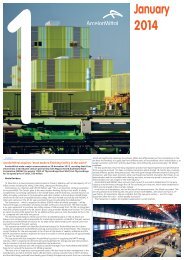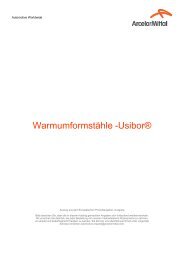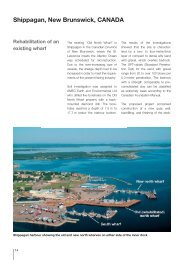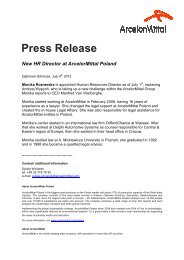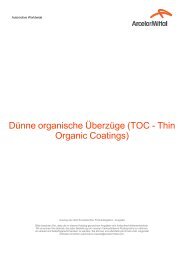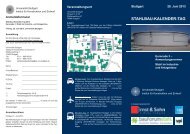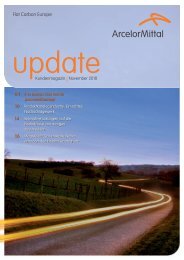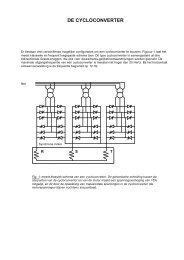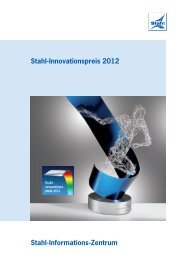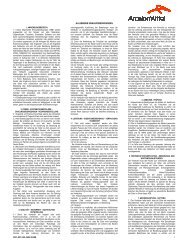ArcelorMittal Annual Report 2008
ArcelorMittal Annual Report 2008
ArcelorMittal Annual Report 2008
Create successful ePaper yourself
Turn your PDF publications into a flip-book with our unique Google optimized e-Paper software.
Deferred tax assets and liabilities are<br />
offset when there is a legally enforceable<br />
right to set off current tax assets against<br />
current tax liabilities and when they relate<br />
to income taxes levied by the same taxation<br />
authority and the Company intends to<br />
settle its current tax assets and liabilities<br />
on a net basis.<br />
Financial instruments<br />
Derivative financial instruments<br />
The Company enters into derivative<br />
financial instruments principally to manage<br />
its exposure to fluctuation in interest rates,<br />
exchange rates, prices of raw materials,<br />
energy and emission rights allowances.<br />
Derivative financial instruments are<br />
classified as current assets or liabilities<br />
based on their maturity dates and are<br />
accounted for at trade date. Embedded<br />
derivatives are separated from the host<br />
contract and accounted for separately if<br />
required by IAS 39, “Financial Instruments:<br />
Recognition and Measurement”.<br />
The Company measures all derivative<br />
financial instruments based on fair values<br />
derived from market prices of the<br />
instruments or from option pricing models,<br />
as appropriate. Gains or losses arising from<br />
changes in fair value of derivatives are<br />
recognized in the statement of income,<br />
except for derivatives that are highly<br />
effective and qualify for cash flow or<br />
net investment hedge accounting.<br />
Changes in the fair value of a derivative<br />
that is highly effective and that is<br />
designated and qualifies as a fair value<br />
hedge, along with the gain or loss on the<br />
hedged asset, liability, or unrecognized<br />
firm commitment of the hedged item<br />
that is attributable to the hedged risk,<br />
are recorded in the statement of income.<br />
Changes in the fair value of a derivative<br />
that is highly effective and that<br />
is designated and qualifies as a cash<br />
flow hedge are recorded in equity.<br />
Amounts deferred in equity are recorded<br />
in the statement of income in the periods<br />
when the hedged item is recognized<br />
in the statement of income and within<br />
the same line item.<br />
The Company formally assesses, both at<br />
the hedge’s inception and on an ongoing<br />
basis, whether the derivatives that are used<br />
in hedging transactions are highly effective<br />
in offsetting changes in fair values or cash<br />
flows of hedged items. When a hedging<br />
instrument is sold, terminated, expires or<br />
is exercised, the cumulated unrealized gain<br />
or loss on the hedging instrument is<br />
maintained in equity until the forecasted<br />
transaction occurs. If the hedged<br />
transaction is no longer probable, the<br />
cumulative unrealized gain or loss, which<br />
had been recognized in equity, is reported<br />
immediately in the statement of income.<br />
Foreign currency differences arising<br />
on the retranslation of a financial liability<br />
designated as a hedge of a net investment<br />
in a foreign operation are recognized<br />
directly as a separate component of equity,<br />
to the extent that the hedge is effective.<br />
To the extent that the hedge is ineffective,<br />
such differences are recognized in the<br />
statement of income.<br />
Non-derivative financial instruments<br />
Non-derivative financial instruments<br />
include cash and cash equivalents,<br />
trade and other receivables, investments<br />
in equity securities, trade and other<br />
payables and debt and other liabilities.<br />
These instruments are recognized initially<br />
at fair value when the Company becomes<br />
a party to the contractual provisions of the<br />
instrument. They are derecognized if the<br />
Company’s contractual rights to the cash<br />
flows from the financial instruments expire<br />
or if the Company transfers the financial<br />
instruments to another party without<br />
retaining control or substantially all risks<br />
and rewards of the instruments.<br />
The Company classifies its investments<br />
in equity securities that have readily<br />
determinable fair values as<br />
available-for-sale which are recorded<br />
at fair value. Unrealized holding gains<br />
and losses, net of the related tax effect,<br />
on available-for-sale equity securities are<br />
reported as a separate component of<br />
equity until realized. Realized gains and<br />
losses from the sale of available-for-sale<br />
securities are determined on a first-in,<br />
first-out basis.<br />
Investments in privately held companies<br />
that are not considered equity method<br />
investments are carried at cost.<br />
Debt and liabilities, other than provisions,<br />
are stated at amortized cost. However,<br />
loans that are hedged under a fair value<br />
hedge are remeasured for the changes<br />
in the fair value that are attributable<br />
to the risk that is being hedged.<br />
Impairment of financial assets<br />
A financial asset is considered to be<br />
impaired if objective evidence indicates<br />
that one or more events have had<br />
a negative effect on the estimated future<br />
cash flows of that asset. Estimated future<br />
cash flows are determined using various<br />
assumptions and techniques, including<br />
comparisons to published prices in an<br />
active market and discounted cash flow<br />
projections using projected growth rates,<br />
weighted average cost of capital,<br />
and inflation rates. In the case of<br />
available-for-sale securities, a significant<br />
or prolonged decline in the fair value of the<br />
security below its cost is considered an<br />
indicator that the securities are impaired.<br />
If any such evidence exists for<br />
available-for-sale financial assets,<br />
the cumulative loss - measured as the<br />
difference between the acquisition cost<br />
and the current fair value, less any<br />
impairment loss on that financial asset<br />
previously recognized in the statement<br />
of income - is removed from equity<br />
and recognized in the statement of income.<br />
89<br />
<strong>2008</strong> Consolidated Financial Statements continued<br />
<strong>ArcelorMittal</strong> <strong>Annual</strong> <strong>Report</strong> <strong>2008</strong>



